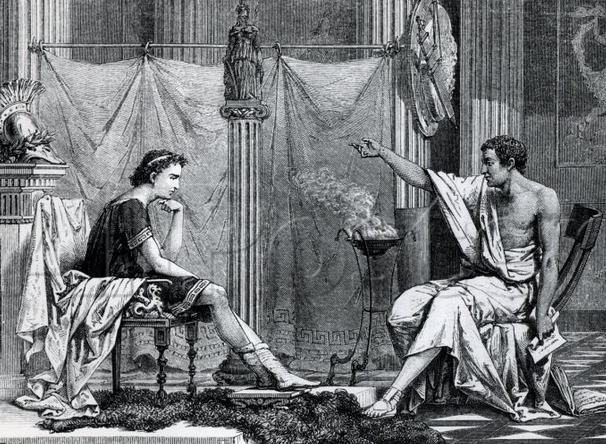Aristotle, Ethics and the ‘Art’ of Leadership
This is one of our free-to-access content pieces. To gain access to all Ideas for Leaders content please Log In Here or if you are not already a Subscriber then Subscribe Here.

Aristotle’s ‘master virtue’ of phronesis, which combines ethics and action so that people can ‘live well’ and be happy, is often seen as the key to effective leadership. But it tends to be too narrowly defined. A re-reading of Aristotle’s Nicomachean Ethics reveals that phronesis is linked not only to knowledge, skill, wisdom and intelligence but also to sensory perception, intuition and aesthetics. For Aristotle, doing the right thing partly depended on seeing and appreciating the fine thing. This raises important questions about how leaders reach their decisions — and about the skills organizational leadership involves.
In Aristotle’s great work the Nicomachean Ethics, happiness (eudaimonia) is not a feeling so much as a state — and a state with a distinctly moral dimension. Synonymous with ‘living well and acting well’, it arises from being part of and being active in a social life and a political community, and it originates in the exercise of virtues.
One virtue is seen as particularly important — phronesis. Sometimes translated (loosely) as ‘prudence’, phronesis is one of Aristotle’s ‘intellectual virtues’, belonging to the ‘rational part of the soul’ (rather than that encompassing emotions, desires and impulses, and ‘moral virtues’ such as self-control and justice). In book 6 of the Nicomachean Ethics, we are told that a person with phronesis is an expert at deliberating for the purpose of living well and doing well and is able to ‘locate’ the ‘correct account’ (the ‘mean’) of a moral virtue in any given situation.
Phronesis is, therefore, critical for decisions promoting eudaimonia — at both the level of the individual and the level of the state. It is, Aristotle tells us, “about having the right feelings at the right time on the right occasion towards the right people for the right purpose and in the right manner.”
Not surprisingly, phronesis has attracted the attention of writers on leadership and of scholars in fields such as the social sciences. (The term ‘phronetic leader’ has joined the modern lexicography of leadership.) Nonetheless, our understanding of what phronesis means remains quite limited.
Given its associations in the Nicomachean Ethics with knowledge, skill, wisdom and intelligence, social scientists have tended to stress its practical and rational aspects. Re-examination of the text, however, can reveal another side.
For Aristotle, phronesis is, it can be argued, not just a rational phenomenon but also one linked to the senses. Located in the ‘calculating’ or ‘deliberative’ subdivision of the rational soul, rather than the scientific part, phronesis is a ‘faculty of discerning’ that’s developed over time. (Men aren’t born with phronesis — they’re made.) Aristotle consistently uses the imagery of sight and seeing to explain the relationship between intelligence and phronesis, understanding and judgment: he tells us that men with phronesis have acquired, through experience, an “eye for things so they can see correctly”; he compares the exercise of phronesis to the kind of intuition mathematicians use to perceive the ‘ultimate figure’, the simple triangle.
More than this, he seems to draw a link between phronesis and the appreciation of what’s aesthetically pleasing. “When there are two possible ways of bringing about the appropriate end,” he tells us, “a person with phronesis will choose the one that is most fine.” Although he never says explicitly what he means by ‘fine’, the quality appears something distinct from (if necessary for) what is ‘good’. The Greek to kalon can also be translated as what is ‘noble’ or ‘beautiful’.
Further, the exercise of phronesis is associated with the experience of personal pleasure. The philosopher even tells us that if a man does not experience the pleasure of what is fine in a good action he cannot be called virtuous.
This returns us to the link between virtue and happiness — and suggests an aesthetic dimension to “living well and acting well”. For Aristotle, in other words, ethics, aesthetics and eudaimonia intersect. Understanding this is important for leaders today.
Links between phronesis and intuition and the senses strengthen the case for ‘organizational aesthetics’. Originating in the 1980s, the field of organizational aesthetics has developed considerably over the past 30 years, and now includes a number of approaches. Some of its theories — and how they might apply in practice — are briefly explained below.

Ideas for Leaders is a free-to-access site. If you enjoy our content and find it valuable, please consider subscribing to our Developing Leaders Quarterly publication, this presents academic, business and consultant perspectives on leadership issues in a beautifully produced, small volume delivered to your desk four times a year.

For the less than the price of a coffee a week you can read over 650 summaries of research that cost universities over $1 billion to produce.
Use our Ideas to:
Speak to us on how else you can leverage this content to benefit your organization. info@ideasforleaders.com